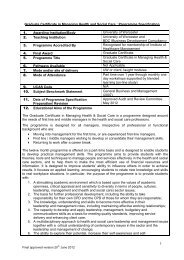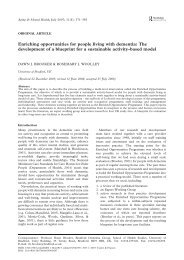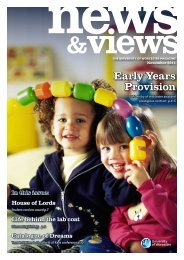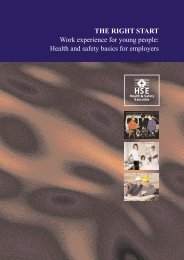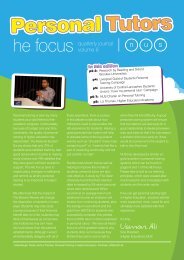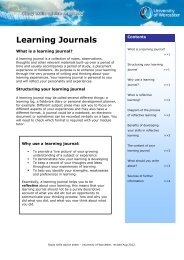Including children with cerebral palsy in mainstream physical
Including children with cerebral palsy in mainstream physical
Including children with cerebral palsy in mainstream physical
You also want an ePaper? Increase the reach of your titles
YUMPU automatically turns print PDFs into web optimized ePapers that Google loves.
Hilderley & Rh<strong>in</strong>d<br />
<strong>Includ<strong>in</strong>g</strong> <strong>children</strong> <strong>with</strong> cp <strong>in</strong> <strong>physical</strong> education<br />
Data Analysis<br />
Content analysis is a process by which large amounts of qualitative data are<br />
organized through cod<strong>in</strong>g the <strong>in</strong>formation <strong>in</strong>to categories that concern similar<br />
themes. It was deemed to be the most appropriate approach <strong>in</strong> the present research<br />
because it would allow the identification of salient themes across participants’<br />
responses. Salience was judged based on the frequency and <strong>in</strong>tensity of comments<br />
and was highlighted through discussions between the authors.<br />
The analytical process commenced by read<strong>in</strong>g all pages of the transcribed data to<br />
<strong>in</strong>crease our understand<strong>in</strong>g of the <strong>in</strong>formation that was obta<strong>in</strong>ed from the<br />
participants. Data from all participants (i.e., students, teachers and support workers)<br />
were content analysed together. Both authors analysed the data on the basis that a<br />
raw data unit represented a “quote” (i.e., a complete sentence/s that referred to a<br />
dist<strong>in</strong>ct benefit or barrier and made sense as a stand-alone unit). Mean<strong>in</strong>g units were<br />
reviewed to highlight those which related to a possible benefit or barrier. The<br />
mean<strong>in</strong>g units were then <strong>in</strong>ductively analysed <strong>with</strong><strong>in</strong> these categories to identify<br />
salient themes. The authors then <strong>in</strong>dependently reviewed the <strong>in</strong>itial categorizations<br />
to confirm that all of the quotes were correctly classified. Mean<strong>in</strong>g units which<br />
focused on a related topic were then grouped to form lower order themes which <strong>in</strong><br />
turn were grouped to create higher order themes.<br />
As a further check, once the authors were satisfied <strong>with</strong> all the classifications, the<br />
categories and subcategories were given to an <strong>in</strong>dependent psychology researcher<br />
who was asked to assign each subcategory (lower order theme, specific) to the most<br />
appropriate category (higher order theme, general). Then, the same researcher<br />
categorized the quotes <strong>in</strong>to the most appropriate lower order theme. The responses<br />
supplied were 90% <strong>in</strong> agreement <strong>with</strong> the authors’ categorizations, demonstrat<strong>in</strong>g<br />
some evidence of <strong>in</strong>ter-rater reliability. F<strong>in</strong>ally, the participants were provided <strong>with</strong><br />
the themes and <strong>in</strong>vited to make further comments (cf. L<strong>in</strong>coln & Guba, 1985). This<br />
helped to confirm that the salient themes had been identified.<br />
RESULTS<br />
All participants were able to identify benefits of PE and school sport for students <strong>with</strong><br />
CP. Three higher order themes emerged from the data: psychological (i.e.,<br />
enhanced self-esteem and body image, enjoyment and a sense of freedom), social<br />
(i.e., be<strong>in</strong>g part of the group, develop<strong>in</strong>g relationships and social skills) and <strong>physical</strong><br />
(i.e., mobility). Barriers to <strong>in</strong>clusion were also identified. Four key themes emerged:<br />
environmental (i.e., appropriate equipment and facilities), organizational (i.e.,<br />
appropriate staff, health and safety, and class sizes), the disability (i.e., <strong>physical</strong><br />
aspects and the wheelchair), and attitudes (i.e., of peers, staff and the child). The<br />
participants also suggested improvements for the provision of PE for students <strong>with</strong> a<br />
disability. These improvements were related to teacher tra<strong>in</strong><strong>in</strong>g or the adaption of<br />
activities. The follow<strong>in</strong>g section considers the major themes that emerged from the<br />
data collection, <strong>in</strong>clud<strong>in</strong>g illustrative quotes from the participants. The participants<br />
have been assigned different names to protect their anonymity.<br />
Psychological Benefits<br />
The participants felt that <strong>in</strong>clusion could potentially enhance the self-esteem, body<br />
image and enjoyment of <strong>children</strong> <strong>with</strong> CP as well as giv<strong>in</strong>g them a sense of freedom.<br />
© 2012 GJSEPER 6





